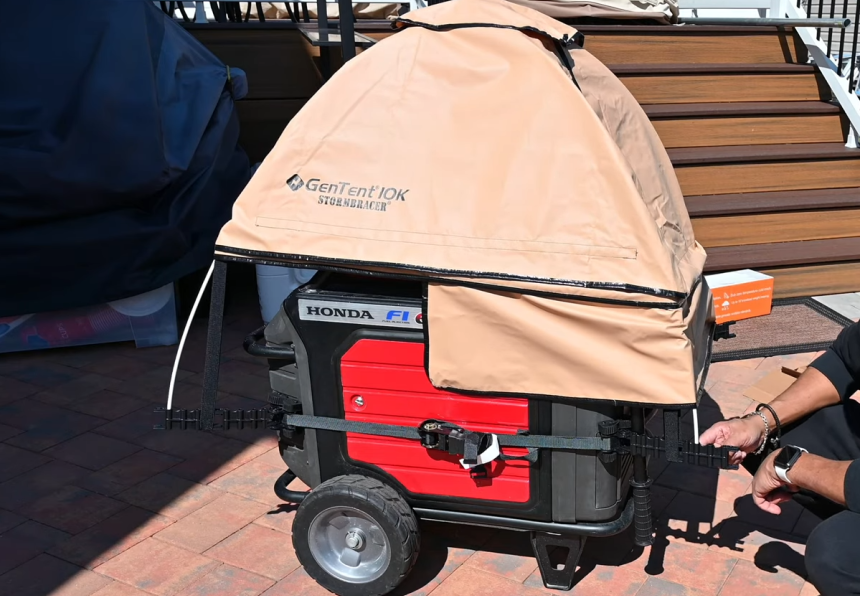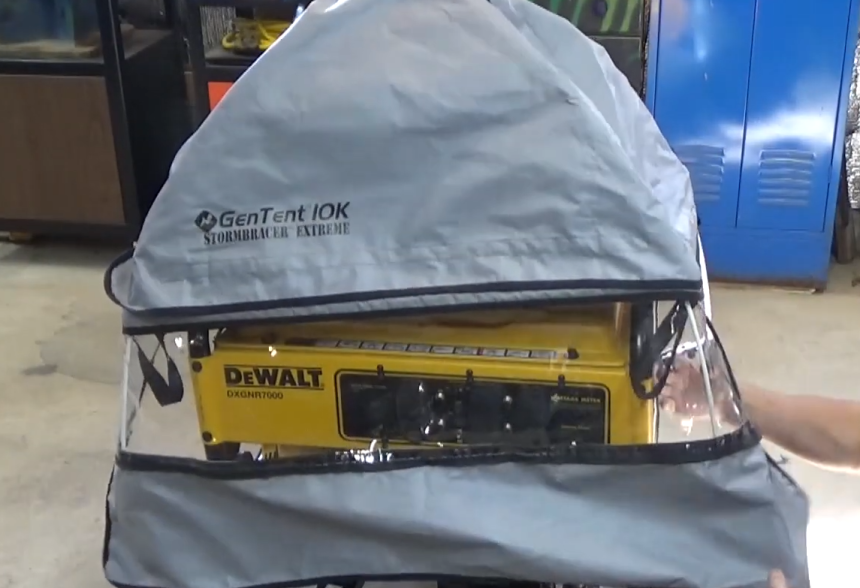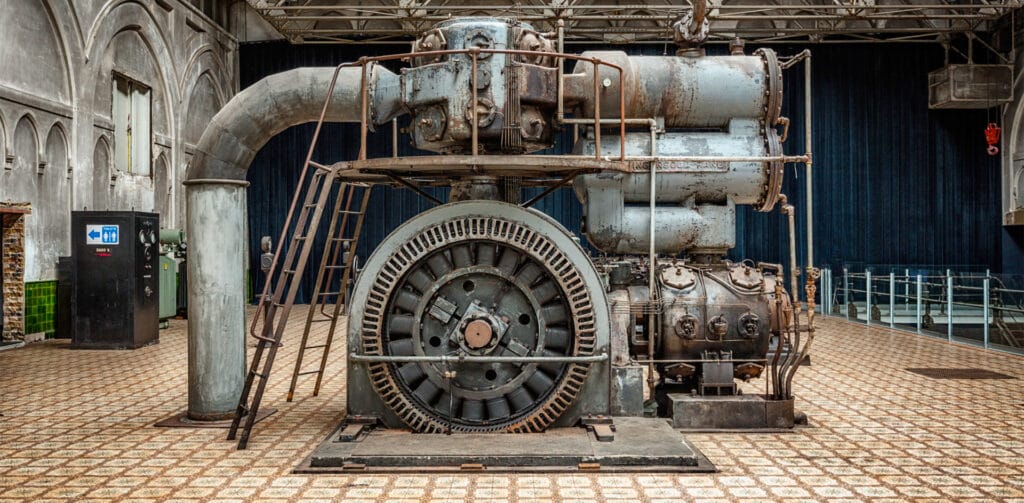

Portable generators are modern miracles, allowing you to have power on the go anywhere you need it. However, they do have one critical weakness – portable generators can’t safely be used in the rain because there’s a chance for electrocution if they get soaked.
That’s where the GenTent generator cover comes in. This unique, simple, and effective cover protects your portable generator from rain, allowing you to get the power you need no matter what weather conditions are like. In our GenTent review, we’ll take a look at how this portable generator cover works and whether it can allow you to use your generator even in stormy conditions. Specifically, we’ll look closely at the GenTent 10k Stormbracer kit, which is designed to work with portable generators rated for between 3,000 and 10,000 output watts.
The number one reason to get a cover for your generator is that you simply can’t always know what the weather is going to be like. It’s almost never safe to use a generator inside, but you also need to keep your generator dry to operate it safely. So, rain and wet weather presents a major problem for portable generators if you don’t have a cover.
There are tons of scenarios in which a cover is essential. If you’re planning to use your generator as a home backup during a storm, you need to be able to safely run your generator during the storm itself. That means protecting it from the rain and snow, even if it’s blowing sideways. If you use your generator for camping or tailgating, having a cover helps ensure that you can get power no matter what the weather is like.
To help you determine whether the GenTent cover is right for your portable generator, we’ll take a closer look at the 10k Stormbracer model. This cover is designed for generators producing between 3,000 and 10,000 watts. We’ll also discuss the differences between the Standard and Extreme versions of the GenTent 10k Stormbracer to help you determine which model is better for the conditions you expect.

Once the clamps are in place, you can assemble the collapsible tent pole system that comes with the kit. This forms a dome that’s large enough for most 10,000-watt generators, so you don’t have to worry much about the dimensions of your unit. With the poles in place, simply drape the tent cover over the poles and attach it to the clamps at each corner.
Most users reported being able to get the entire GenTent cover assembled in less than five minutes. If you already have the clamps attached to your frame, the process can take less than two minutes.
One important thing to note about this process is that it does require a generator with an external frame. This excludes a large number of fully contained 3,000- to 4,000-watt inverter generator models. GenTent does make generator covers for inverter generators, but you can’t use the 10k Stormbracer in that case.
It’s crucial to take a close look at what the tent cover and poles are made of, since these are potentially two of the weakest points of the entire setup if you want to use your generator during a severe storm.
The poles on the GenTent are made from fiberglass. That in itself is pretty strong, although the fairly thin diameter of the poles leaves us wondering whether the tent can truly stand up to strong winds. However, multiple users have reported using the Stormbracer during hurricanes without any damage to the poles. It turns out, the thin diameter of the poles allows them to bend without breaking – it’s part of the ingenious design, rather than a flaw.
The tent cover itself is made from pretty serious stuff. The outer layer, which is exposed to the wind, rain, and sun, is a completely watertight synthetic material with welded seams. It’s a lot thicker and more resilient than the material you’d find in a lightweight camping tent. Plus, beneath that, there’s a layer of dual-coated marine-grade vinyl to provide support. Finally, a third layer of ripstop nylon ensures that even if water manages to penetrate the first two layers, it won’t be able to seep through to reach your generator.

According to GenTent, which has tested the Stormbracer extensively, the cover is equipped to handle wind gusts up to 70 miles per hour without any issues. It can also be used in snow – while users haven’t tested this capability quite as much, GenTent reports that the cover will support up to 18 inches of snow without the poles collapsing downward.
One of the critical elements of the GenTent cover is that while it keeps your generator extremely well protected from the weather, it also allows your generator to vent enough that carbon monoxide and heat don’t build up. It seems to accomplish this well thanks to cut out panels that keep your engine out of the tent itself.
This does allow the engine to get wet when rain is blowing sideways, so you’ll need to orient the generator appropriately to balance ventilation with protection.
Once again, the design of the GenTent cover helps here. Since you get to decide where to place the clamps on your generator’s frame, it’s relatively easy to move it up or down to adjust for the location of your generator’s engine. It’s important not to cover it, even though it’s tempting to give your generator as much protection from the elements as possible.
It’s also worth pointing out that the GenTent cover allows your generator to remain portable. You could, in theory, achieve the same level of protection by simply placing your generator under a metal enclosure. However, in doing so, you would no longer be able to move your generator around as needed. The GenTent 10k Stormbracer doesn’t interfere with the wheels of your generator, and you can even store it without removing the cover.
GenTent offers two different versions of the 10k Stormbracer: Standard and Extreme. In most ways, the two models are very similar. In fact, the clamp systems and poles are exactly the same. All of the key differences between the Standard and Extreme versions are in the canopies.
First, the tent cover material in the Extreme version of the 10k Stormbracer is treated to be UV resistant. That’s an advantage if you leave the tent cover on most of the time, even when the weather is sunny. Without this UV resistance treatment, the GenTent cover can wear down over time and develop cracks in the fabric that will allow water to leak in.
The second difference is in how the fabric responds to cold weather. The Standard 10k Stormbracer tent cover is rated to withstand temperatures down to -15°F without cracking and allowing water to seep in.
If you live in particularly cold areas and need to use your generator to power your home during snowstorms, the Extreme version can handle temperatures down to -45°F.
There are a number of other smaller differences between the Standard and Extreme versions as well. The Standard version is manufactured in China, using primarily Chinese fabrics. The Extreme version is manufactured in the US, using American and Canadian fabrics. In theory, there shouldn’t be any difference in quality, but in reality, it’s a lot more certain that you’re going to get a solid product if it’s American-made.
Another difference worth noting is that the warranty on the canopy of the GenTent Extreme model is three years. On the Standard model, you only get a one-year warranty.
The 10k Stormbracer is far from the only portable generator cover that GenTent makes. It’s worth highlighting three additional models that you can use for your generator: the GenTent 10k XKU, the GenTent 20k Extreme, and the GenTent 10k XKI.
The GenTent 10k XKU is GenTent’s answer to the frameless design of many modern inverter generators. This kit uses a ratchet strap around the outside of your generator to attach clamps that the tent poles can connect to. It’s a little more difficult to set up the first time around, but it’s not hard once you get the hang of it. Note that the 10k XKU also leaves more space for ventilation, so it does rely on the fact that your inverter generator’s casing is itself waterproof in most conditions.
The GenTent 20k Extreme is made for heavy-duty generators capable of putting out more than 10,000 watts of power. It uses much the same clamp system as the 10k Stormbracer, and the specs of the tent canopy are the same as for the 10k Stormbracer Extreme. One notable addition to the canopy on the 20k Extreme is a see-through skirt around the bottom of the canopy. This allows you to see your generator’s digital hour meter if it has one on the side of the unit.

| PROS | CONS |
|
|





